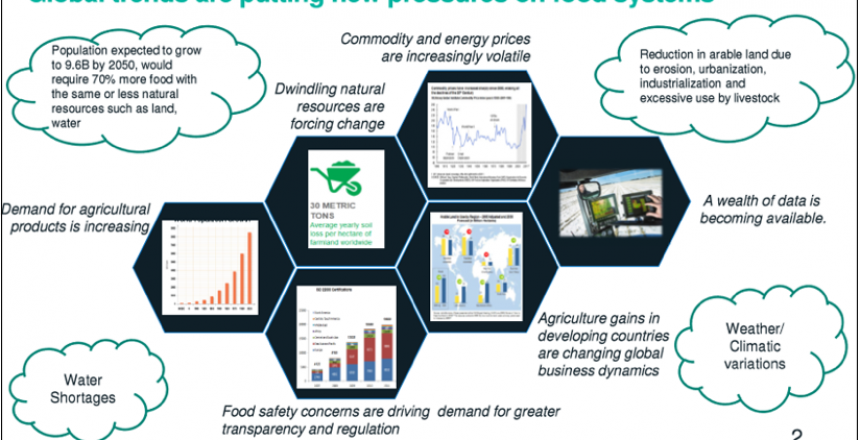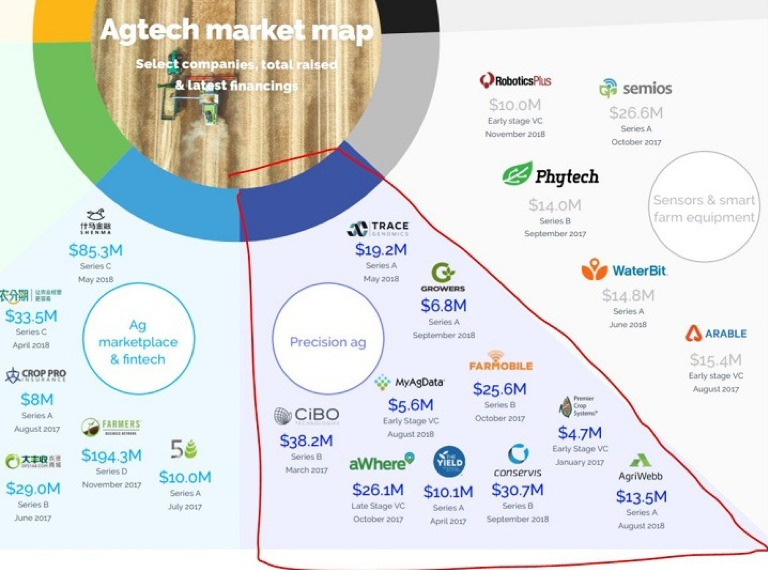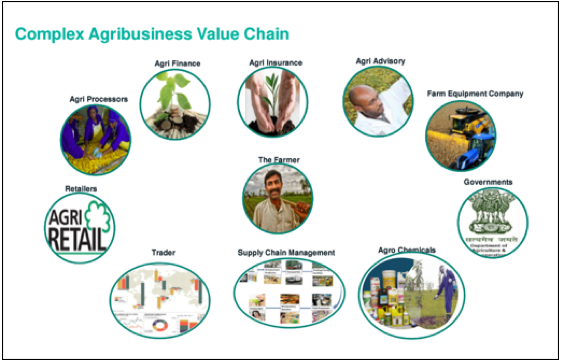AgriTech - A Data-Driven Solution To Agriculture.

THE world population is expected to grow from seven billion to 9.6 billion by 2050. We would require 70% more food than what we produce now with the same or less natural resources like land and water due to urbanization, soil erosion, climatic changes, water shortages, and excessive use by livestock.
Agriculture is at the heart of our daily lives. We need farmlands to survive. It contributed 8.2% to the national GDP in 2017 and provides employment for 28 % of the population.
The agricultural value chain is very complex and inefficient, burdened with almost 33% wastage due to poor logistics and storage, exorbitant lending rates, and poor insurance coverage. Farmers who toil the most continue to remain poor, being at the bottom of the value chain while the middlemen continue to make the most significant profits.
So, what does the future hold for agriculture? How do we feed the exploding world population while simultaneously providing employment opportunities and improving our country’s economy? How do we enhance the quality of life of the farmers?
Precision agriculture could just be the answer.
Agriculture in Malaysia
Rice, food crops, rubber, palm oil. Agriculture plays a crucial role in our economy, both for exports and local consumption. Occupying a dominant position in the Malaysian economy, it is the backbone of the country, providing raw material, food, export revenue, and employment opportunities.
Being one of the largest sectors in both our local and global economies, it is facing challenges in a rapidly evolving world.
To compete in an increasingly competitive and volatile market, we need to refine the way our farming industry operates – precision agriculture is the answer.
Are we overly dependent on palm oil exports? What if there is a change in the world sentiment on palm oil consumption? How will it impact Malaysia? Do we need a plan B? What is the next best alternative to palm oil? Are there cash crops that can replace palm oil dependence?
What is precision agriculture?
In a nutshell, precision agriculture (PA) or smart farming is the optimization of inputs like water, fertilizers, pesticides, and tools to enhance yield, quality, and productivity. The farming management concept centers around observing, measuring, and responding to inter-and intra-field variability in crops using satellite farming or site-specific crop management (SSCM).
By using information technology like satellites, drones, artificial intelligence, and weather forecasting tools, we can ensure that the crops and soil receive accurately what is needed for optimum health and productivity, thus preventing wastage in not only supply but also time.
Do you know it requires almost 4,000 liters of water to produce one kg of rice? Do you also know that it takes anywhere between 300 to 400 kg of base fertilizer per hectare of production land? Is this necessary? Can this be scientifically reduced without compromising the quality or the yield? Can we detect pests much earlier using drones and spray pesticides only in targeted areas rather than carpet-bombing the entire field?
A group of broadminded Indian Institute of Technology (IIT) students has come forward to adopt multiple villages to provide these services for a nominal fee. To add to their already compelling value proposition, they are also offering tractors on-demand in a Uber-like service.
Rather than depending solely on people to look at the leaves and soil of the crops to decide what is needed, we have satellites and robotic drones overlooking the crops and providing farmers with real-time images of individual plants.
Information from those images can be processed and integrated with sensors and other data to yield guidance for immediate and future decisions, such as precisely what fields to water and when or where to plant a particular crop.
Why should we adopt smart-farming
According to the United Nations Food and Agriculture Organisation (FAO), up to one-third of all the food produced globally goes to waste, which amounts to about 1.3 billion tonnes per year. In a world, where about one in nine people do not have enough food (that’s 795 million people), food waste presents an enormous opportunity for tackling food insecurity.
With current farming practice, we face some key challenges such as;
- Low crop yield – unpredictable weather conditions and inefficient techniques are amongst the few factors that reduce crop produce
- Variation within farms and region – based on resource endowments, location topography, and farmers circumstances
- Lack of ability to manage calamities – Impacts from natural events and disasters include contamination of water bodies, loss of harvest, and destruction of irrigation systems and other agricultural infrastructure
- Produce wastage – Seeds of poor quality, inadequate farming practices, or insect attacks in the field can provoke losses of products even before their harvest.
It’s all about enabling today’s farmers with technologies that will help increase profits and reduce risks. We’re not just talking about information technology, but a broad range of other technologies including telematics, GPS assistance, robotics, automated hardware, agriculture drones, and variable rate technology.
Other examples of successful AgriTech startups investments are as follows:

We cannot just start planting more crops on new land without any strategies in place. Land costs money. Instead, we need to make better use of our existing farmlands. To do that, farmers are looking towards technology to boost yields while helping to manage costs.
Assuming we have 50 million oil palm trees in Malaysia and each pod of palm seeds costs RM12, we are talking about getting an incremental RM600 million for every one unit of increase in yield.
Should this be done manually employing 25,000 people or by using smart Internet of Things (IOT) devices connected to a central NOC (Network Operations Centre)? The answer is obvious. Again, the incremental revenue and profits will justify investments in technology.
Reducing wastage across the value chain
Having demonstrated why precision agriculture is key and why we should embrace smart-farming, wastages are not just in the farms but also throughout its value chain.
The agricultural value chain is very complex and there are efficiency challenges in every aspect of it
- Farmer selection of crops
- Weather prediction
- Production / Water / Fertilisers / Pesticides
- Farm Equipment
- Insurance
- Finance and Banks
- Agri advisory
- Supply chain – Rail / Road / Ship etc
- Traders
- Retail
- The farmer gets squeezed in the middle
At every stage, be it storage, transportation, retail or wholesale, technology can help enhance efficiency.
The hardest working community within the value chain are the farmers and they continue to stay poor as they are the lowest on the value chain. The middlemen including the unorganized lenders, warehouse keepers, transporters, and middlemen make substantial profits compared to the average farmer.

A time for change – Use technology and analytics
In the past, precision agriculture was limited to larger operations that could support the IT infrastructure and other technology resources required to fully implement and benefit from the benefits of precision agriculture.
Today, however, mobile apps, smart sensors, drones, and cloud computing makes precision agriculture possible for farming cooperatives and even small family farms.
When it comes to our current farming culture, the average Malaysian farmer is 50-years-old, hence, incorporating or adopting new farming technology is challenging, especially as rural youths tend to relocate to urban centers with the promise of employment and a modern lifestyle. This can, and will, add pressure to the volume outputs.
So how can we retain the next generation within the farming industry? By embracing change. By changing the old practices to incorporate the new, we can attract the youth who are tech-savvy with employment opportunities in the form of a modern, hi-tech farm.
Analytics, especially for small and medium farmers, is starting to emerge as a significant enabler to improve the gains larger enterprises have seen especially in developed counties such as the US. The increased access and significantly reduced cost associated with cloud computing have seen a surge in tools and software enabling the smaller farmer to leverage big data analytics.
Developments, as seen from the research undertaken by Microsoft in India, are facilitating a low-cost entry point for all farmers. These technologies are utilizing smartphone capabilities and low-cost sensors and are making analytics an option for most farmers globally by reducing costs from US$1000s to US$100s.
Analytics has often been seen as the home of tech-savvy millennials. However, the development of mobile apps with a focus on simplicity and user experience will open up analytics for all.
Analytics will be core to driving both improved yields and helping deliver economic benefits for the modern farmer. Productivity will be focused, not on extra manpower (limiting average incomes) but on Data and Technology. Technology should not be perceived as a threat to farmers’ incomes but as the facilitator to grow long-term real incomes within the sector.
Moving forward
Change is not easy. Financial means to adopt such technology at this stage can be daunting and unnerving; especially if most farmers are already in debt, paying high-interest rates as they work hard to bear the fruits of their labor – only to have the middleman earning the bigger part of their profits.
This is where the government can provide an extension of assistance. By expanding favorable financial schemes, we can enable farmers to upgrade and modernize their farms. A learning institution or outsourcing service can also be formed to encourage and help farmers to put smart farming into practice.
IR 4.0 is probably the best platform to drive changes in increasing productivity and support the shift towards innovation- and knowledge-based economy. These initiatives will allow farms to be more profitable, efficient, safe, and environmentally friendly.
The future
The World Economic Forum is currently supporting agricultural transitions in 21 countries through its “New Vision for Agriculture” initiative. This initiative supports “innovation ecosystems” to re-engineer food systems based on “12 transforming technologies”.
In this imagined future, next-generation biotechnologies will re-engineer plants and animals. Precision farming will optimize the use of water and pesticides. Global food systems will rely on smart robots, blockchain, and the internet of things to manufacture synthetic foods for personalized nutrition.
With a worrying global trend of proliferating commodity prices, water scarcity, population growth, and the affluent demanding more consumption and erratic weather conditions amongst the few, a new smart and high-tech era will need to be introduced.
Precision Agriculture, where data and automation can help farmers address the many challenges of the future, will be the way to go.
Sharala Axryd is the founder and CEO of The Center of Applied Data Science (CADS) while Chari TVT is a consultant & Board of Advisory, CADS.
*This article was first published on Digital News Asia





